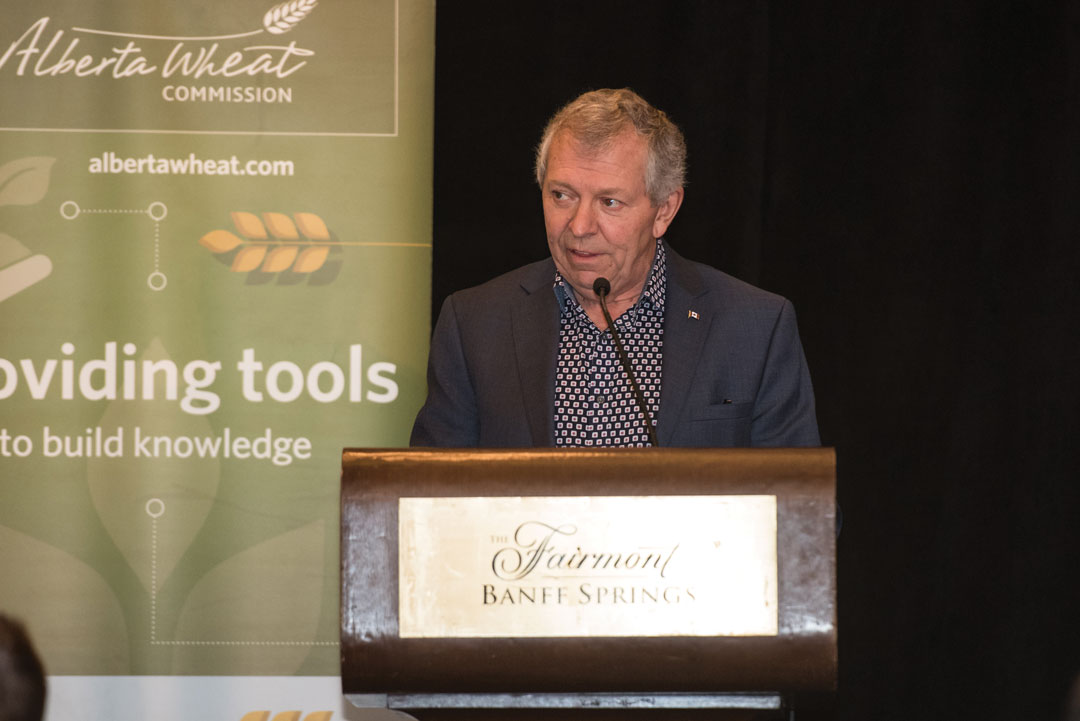RESPONSIBLE GRAIN MOVES AHEAD
BY JENNIFER BARBER • PHOTO BY ROB MCMORRIS PHOTOGRAPHY: TED MENZIES, CANADIAN ROUNDTABLE FOR SUSTAINABLE CROPS CHAIR, ADDRESSED THE 2019 PRAIRIE CEREALS SUMMIT
Throughout the winter months, grain industry groups, stakeholders and farmers across Canada will have the opportunity to provide input on the first draft of the code of practice developed by the Canadian Roundtable for Sustainable Crops (CRSC). Dubbed “Responsible Grain,” the code has been drawn up over the past year-and-a half and the CRSC is ready for feedback.
“The initial reasoning behind this effort was research done several years ago that showed a lack of public trust in agriculture and food production,” said Ted Menzies, CRSC chair. “What the public was saying about the industry was not a good reflection of what agriculture was actually doing. We realized that farmers from east to west, importers and exporters, NGOs, everyone in the grain industry needed to do a better job of communicating that we are growing food responsibly.”
The code of practice will be voluntary and not require a certification process. Metrics will be developed by the CRSC to monitor and promote continuous improvement. The committee is looking for input with the goal of crafting a code that is achievable on any farm no matter the soil type, farming conditions or location.
“This is the first code of practice in the grains sector and is [designed] to help facilitate and maintain public trust in agriculture,” said Susie Miller, CRSC executive director. “We looked at models such as the animal care code of practice to find models to emulate, but to make it work for the grains industry it took time to develop.”
Developed by farmers and industry experts, Responsible Grain is a science-based code of practice that demonstrates how Canadian farms preserve land, air, water and human resources. The CRSC examined regulations and laws in jurisdictions across Canada to ensure recommendations mesh with existing environmental farm programs. The code of practice also addresses issues of interest or concern to grain buyers and consumers in Canada and abroad.
“We need to be able to demonstrate to export markets what we are doing through modules in the code,” said Menzies. “They will detail how we are rotating crops and chemistries, that we are preventing soil erosion, being cautious of fertilizer runoff. While not the core focus, it will also show that we respect the wildlife and biodiversity on our farms, treat our employees safely and that we are protecting those who work throughout the industry.”
While initial public consultations were planned for summer 2020, COVID-19 restrictions intervened. The code committee of farmers and industry players such as marketers, shippers and conservation groups, was unable to meet in the spring to finalize wording. The decision was made to release the draft code for input from farmers and industry stakeholders after harvest. Its launch is planned for spring of 2021, with an additional year for implementation.
The draft code will be sent to Canadian agriculture groups for limited in-person consultations as well as online feedback, which will include a downloadable, interactive questionnaire that will display results.
“This code will provide farmers with an outline of what’s expected from them by customers, the public and the rest of the industry,” said Miller. “It can also identify what’s important in terms of achieving goals. It will describe to others what it is that you do, then you can use the data to demonstrate your usual practices. The code of practice will be extremely useful in identifying the steps Canadian producers take in protecting the environment and the people in it.”







Comments